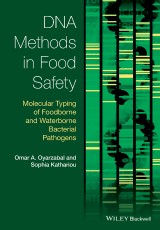Details

DNA Methods in Food Safety
Molecular Typing of Foodborne and Waterborne Bacterial Pathogens1. Aufl.
|
148,99 € |
|
| Verlag: | Wiley-Blackwell |
| Format: | EPUB |
| Veröffentl.: | 21.08.2014 |
| ISBN/EAN: | 9781118278659 |
| Sprache: | englisch |
| Anzahl Seiten: | 408 |
DRM-geschütztes eBook, Sie benötigen z.B. Adobe Digital Editions und eine Adobe ID zum Lesen.
Beschreibungen
<p>Molecular typing of foodborne pathogens has become an indispensable tool in epidemiological studies. Thanks to these techniques, we now have a better understanding of the distribution and appearance of bacterial foodborne diseases and have a deeper knowledge of the type of food products associated with the major foodborne pathogens. Within the molecular techniques, DNA-based techniques have prospered for more than 40 years and have been incorporated in the first surveillance systems to monitor bacterial foodborne pathogens in the United States and other countries. However, DNA techniques vary widely and many microbiology laboratory personnel working with food and/or water face the dilemma of which method to incorporate.</p> <p><i>DNA Methods in Food Safety: Molecular Typing of Foodborne and Waterborne Bacterial Pathogens</i> succinctly reviews more than 25 years of data on a variety of DNA typing techniques, summarizing the different mathematical models for analysis and interpretation of results, and detailing their efficacy in typing different foodborne and waterborne bacterial pathogens, such as <i>Campylobacter, Clostridium perfringens, Listeria, Salmonella,</i> among others. Section I describes the different DNA techniques used in the typing of bacterial foodborne pathogens, whilst Section II deals with the application of these techniques to type the most important bacterial foodborne pathogens. In Section II the emphasis is placed on the pathogen, and each chapter describes some of the most appropriate techniques for typing each bacterial pathogen.</p> <p>The techniques presented in this book are the most significant in the study of the molecular epidemiology of bacterial foodborne pathogens to date. It therefore provides a unique reference for students and professionals in the field of microbiology, food and water safety and epidemiology and molecular epidemiology.</p>
<p>List of Contributors vii</p> <p>Preface xiii</p> <p><b>Section I Typing Method, Analysis, and Applications 1</b></p> <p>1 Polymerase Chain Reaction-Based Subtyping Methods 3<br /> <i>Yi Chen and Insook Son</i></p> <p>2 Pulsed-Field Gel Electrophoresis and the Molecular Epidemiology of Foodborne Pathogens 27<br /> <i>Mohana Ray and David C. Schwartz</i></p> <p>3 Multilocus Sequence Typing: An Adaptable Tool for Understanding the Global Epidemiology of Bacterial Pathogens 47<br /> <i>Stephen J. Knabel</i></p> <p>4 High-Throughput Sequencing 65<br /> <i>Xiangyu Deng, Lee S. Katz, Patricia I. Fields, and Wei Zhang</i></p> <p>5 Analysis of Typing Results 85<br /> <i>João André Carriço and Mário Ramirez</i></p> <p>6 Databases and Internet Applications 113<br /> <i>G. Gopinath, K. Hari, R. Jain, M. H. Kothary, K. G. Jarvis, A. A. Franco, C. J. Grim, V. Sathyamoorthy, M. K. Mammel, A. R. Datta, B. A. McCardell, M. D. Solomotis, and Ben D. Tall</i></p> <p>7 The Transformation of Disease Surveillance, Outbreak Detection, and Regulatory Response by Molecular Epidemiology 133<br /> <i>David A. Sweat</i></p> <p><b>Section II Pathogens 163</b></p> <p>8 The Genus Bacillus 165<br /> <i>Monika Ehling-Schulz and Ute Messelhäusser</i></p> <p>9 Molecular Typing of Campylobacter jejuni 185<br /> <i>Catherine D. Carrillo and Omar A. Oyarzabal</i></p> <p>10 DNA Typing Methods for Members of the Cronobacter Genus 205<br /> <i>Susan Joseph and Stephen Forsythe</i></p> <p>11 Molecular Subtyping Approaches for Pathogenic Clostridium spp. Isolated from Foods 249<br /> <i>Brian H. Raphael, Deborah F. Talkington, Carolina Lúquez, and Susan E. Maslanka</i></p> <p>12 Molecular Characterization of Shiga Toxin-Producing Escherichia coli 275<br /> <i>Pallavi Singh and Shannon D. Manning</i></p> <p>13 Molecular Subtyping Methods for Listeria monocytogenes: Tools for Tracking and Control 303<br /> <i>Sara Lomonaco and Daniele Nucera</i></p> <p>14 Salmonella 337<br /> <i>Aaron M. Lynne, Jing Han, and Steven L. Foley</i></p> <p>15 Vibrio cholerae 359<br /> <i>Dong Wook Kim</i></p> <p>Index 381</p>
<p><b>Dr Omar A. Oyarzabal </b>is Vice President of Technical Services at IEH Laboratories and Consulting Group, Seattle, WA</p> <p><b>Dr Sophia Kathariou</b> is Professor of Bioprocessing and Nutrition Sciences at the Department of Food, North Carolina State University, Raleigh, USA</p>
<p>Molecular typing of foodborne pathogens has become an indispensable tool in epidemiological studies. Thanks to these techniques, we now have a better understanding of the distribution and appearance of bacterial foodborne diseases and have a deeper knowledge of the type of food products associated with the major foodborne pathogens. Within the molecular techniques, DNA-based techniques have prospered for more than 40 years and have been incorporated in the first surveillance systems to monitor bacterial foodborne pathogens in the United States and other countries. However, DNA techniques vary widely and many microbiology laboratory personnel working with food and/or water face the dilemma of which method to incorporate.</p> <p><i>DNA Methods in Food Safety: Molecular Typing of Foodborne and Waterborne Bacterial Pathogens</i> succinctly reviews more than 25 years of data on a variety of DNA typing techniques, summarizing the different mathematical models for analysis and interpretation of results, and detailing their efficacy in typing different foodborne and waterborne bacterial pathogens, such as <i>Campylobacter, Clostridium perfringens, Listeria, Salmonella,</i> among others. Section I describes the different DNA techniques used in the typing of bacterial foodborne pathogens, whilst Section II deals with the application of these techniques to type the most important bacterial foodborne pathogens. In Section II the emphasis is placed on the pathogen, and each chapter describes some of the most appropriate techniques for typing each bacterial pathogen.</p> <p>The techniques presented in this book are the most significant in the study of the molecular epidemiology of bacterial foodborne pathogens to date. It therefore provides a unique reference for students and professionals in the field of microbiology, food and water safety and epidemiology and molecular epidemiology.</p>
Diese Produkte könnten Sie auch interessieren:

Agricultural Biodiversity and Biotechnology in Economic Development

von: Joseph Cooper, Leslie Lipper, David Zilberman

213,99 €

Policy Reforms and Agriculture Development in Central Asia

von: Sandjar Djalalov, Suresh Chandra Babu

213,99 €

Regulating Agricultural Biotechnology

von: Richard E. Just, Julian M. Alston, David Zilberman

213,99 €













